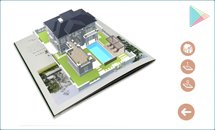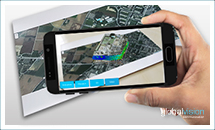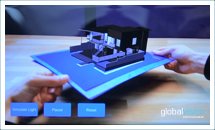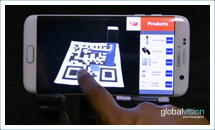Winner of a 2019 POPAI Award, globalvision develops Augmented Reality (AR) applications for a wide range of clients. In industry, watchmaking, medical or consumer products, our experience makes the difference.
Some of the most popular applications are available from our suite of tools (display of photos, videos, 3D models), and can be enhanced with more advanced functions (quizzes, scoring, sending information, etc.) by developing tailor-made AR applications.
Our multidisciplinary team includes 3D designers, interaction designers and coders for IOs and Android in particular. We can transform your script into a truly customised application, while respecting your deadlines and budget.
Many of our creations can be seen in our clients’ publicity campaigns (Coca-Cola, Visilab, SIG, Kahuna), as well as on GlobalVision’s Google Playstore and Apple Appstore developer accounts.
Contact us now to discuss your augmented reality project.
Our Augmented Reality team is made up of designers, data architects and coders, whose role is to ensure that the project is managed on time and within a realistic budget. See our recent public projects below, or contact us to arrange a meeting.
Concept creation
Our process starts with concept creation, where we work closely with you to understand your vision and requirements. Sometimes this means recreating your objects, sometimes it means modifying existing elements or adapting them for their intended use. We use tools such as Adobe Photoshop or figma to sketch out and refine initial designs for the UI/UX.
Animation
If your project requires animated 3D models, our team can animate them using Sketchup, Blender or 3DSmax. We can animate everything from simple mechanical movements to complex character animations, adding a dynamic element to your 3D assets. You can manipulate tools and objects, simulate their actions or create model variations.
MOBILE APPLICATION OR WEBAPP?
Finally, our AR creations can be viewed in two possible ways: via a mobile application (IOs/Android) or directly in a browser. The technologies used vary, and this relatively significant difference needs to be taken into account for each use case. Mobile applications are richer in interaction, whereas webAR requires no downloading or installation.
Integration of 3D elements
Our interaction designers then search for or create the 3D models needed to create the AR experience. Sometimes it’s the customers who supply us with their own models and CADs. Sometimes it’s our team that takes care of the 3D design. In this way, the models are optimised for the use case in question.
Other functions
Once all the visual elements have been integrated, it’s now time to think about the other secondary functions, such as object variations and colours, as well as scoring and contact functions, and the ability to interact directly with external API libraries. The VR application can offer even more functions. interaction designers then search for or create the 3D models needed to create the AR experience. Sometimes it’s the customers who supply us with their own models and CADs. Sometimes it’s our team that takes care of the 3D design. In this way, the models are optimised for the use case in question.





